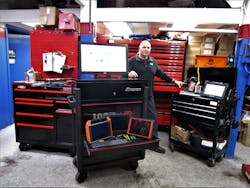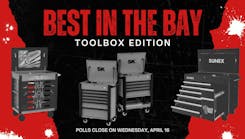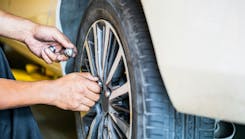"It’s the Lamborghini of boxes.”
That’s how G. Jerry Truglia describes his 84” EPIQ Snap-on toolbox. Five years ago, he traded in his previous Snap-on toolbox to get this bigger version because he just needed more room.
“I was running out of places to really put the tools and I wanted it more centralized,” says Truglia, who is the owner of ATTS (Automotive Technician Training Services) in Mahopac, New York. “But there’s never enough room. When you’ve been in this business as long as me, you keep getting tools — you can’t help it.”
Truglia, who has been in the industry for 47 years, says his toolbox is of great value and he particularly enjoys how he can configure the drawers in whatever way he wants, such as deep or shallow, long or short, side drawers or full length. When it comes to organizing the toolbox, Truglia keeps the most-used items easily accessible and uses the higher-up drawers for those tools he uses less frequently, such as fuel line disconnect tools, spark plug pullers, and a manual hacksaw.
“I’m 6’ tall but this box is taller than me. I sometimes need to use a little step ladder to look in the back of the top drawers,” he says.
His favorite part of his toolbox is his socket drawer.
“It’s nice and big and everything is organized where I can see it all,” he says. “I know where everything is in my head. If I need that particular socket, boom, I go right there.”
When it comes to choosing a favorite tool, Truglia doesn’t skip a beat: it’s the Bullseye Leak Detector from ATS.
“I just used it in a class I taught on Saturday and it found a great leak that I couldn’t find any other way. That tool has made me so much money. It’s a really, really great tool," he says.
Truglia’s shop is under video surveillance and the tools are insured. He and his technicians take pictures of what’s in their toolbox drawers regularly and send them off to their insurance company to stay up on the value of all their tools.
“Some of these things are super expensive to replace even a little piece,” Truglia says. “It’s a huge investment.”
BACKGROUND
Truglia never thought he would work on cars for a living. When he was younger, he was going to school in New York City for criminology to be an FBI agent and was working on cars in his spare time — and making some good money. He started working at Goodyear and they asked him to take the brand-new National Institute for Automotive Service Excellence (ASE) test in 1972. While he didn’t know anything about the test itself, he passed it, won the Gold Wrench award from Goodyear, and got a raise and a bonus. This quickly made him decide to leave his FBI plans behind.
“Am I going to get shot and killed for $30,000 a year back then?” he laughs. “I always loved fixing things and in the old days, you got lots of satisfaction when something wasn’t running well and you made it run well, it was like ‘Oh my God this is great,’ and you felt really good about it.”
Now, Truglia still works on the problem cars that show up at his shop but doesn’t spend much time changing tires or oil. His time is mostly spent in training. He runs a ton of hands-on classes from his shop, including those covering air conditioning, diagnosing hybrid vehicles, and electrical.
People have come from all over the world to take his classes, including Saudi Arabia and Australia. During the pandemic, he did many online videos which enabled him to reach some new clients — so he isn’t slowing down any time soon.
“I don’t see myself retiring right now. I love what I do and I love teaching others,” he says.
In fact, he has taught in every state, except for Montana.
“I might have to do a free class there just for the heck of it,” he laughs.
Running a training business out of his shop means Truglia has even more tools and equipment than other shops might have kicking around. Despite having a “pretty damn big” Snap-on box, Truglia is always needing more. He has three secondary Craftsman toolboxes, a deck above the toolboxes where more tools are stored, various cabinets around his shop, and a truck that stores bigger tools.
“I’m running out of room… I have loads of equipment and I can’t fit much more,” he says.
Truglia takes very good care of his box, and he encourages his technicians to take the same care with their own. He cleans every tool before he puts it back in the box and keeps the box as clean as he can.
“I wax the toolbox like I wax my car, and my guys wax their toolbox as well,” he says, adding he uses touch-up paint on the outside when needed. ““That box was $26,000 — you can buy a car for that… It’s really like a car. You can have a junky car or a nice-looking car — and mine is a nice-looking box.”



